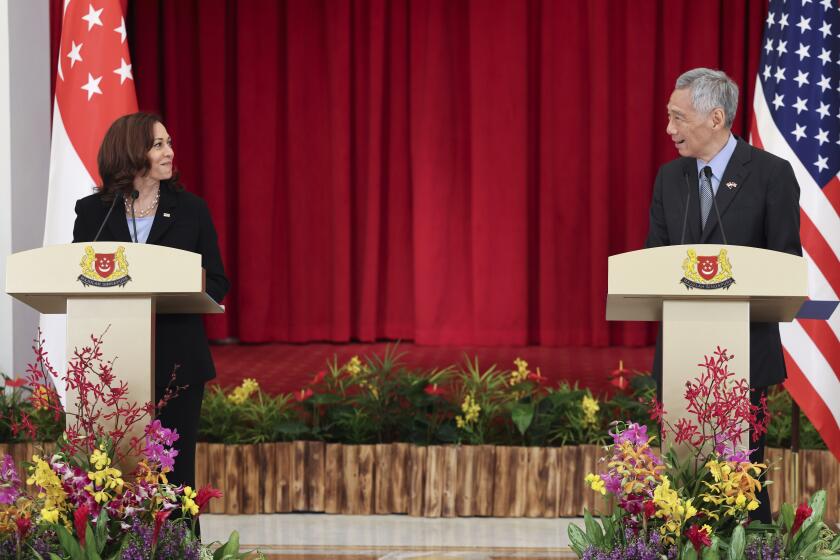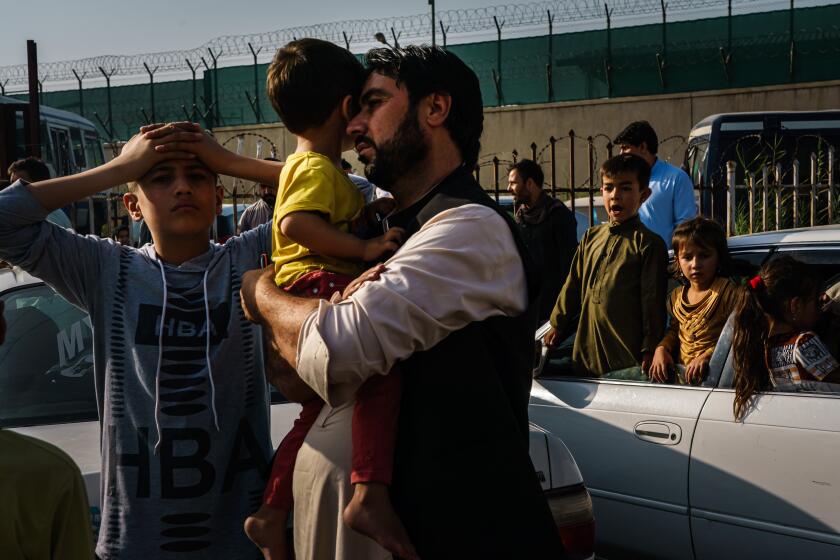Taliban warns of ‘consequences’ if U.S. extends evacuation past August

- Share via
KABUL, Afghanistan — Amid chaos and violence at the Hamid Karzai International Airport in Kabul, U.S. forces have begun conducting missions into the city to ramp up a massive evacuation effort and escort stranded Americans and their Afghan allies to the perimeter of the airfield.
The Pentagon announced Monday that the campaign had accelerated significantly, with 16,000 people transported out of the country in the previous 24 hours — far beyond its earlier goal of 9,000 a day.
In all, 42,000 people have been evacuated since the end of July, including “several thousand” U.S. citizens.
With President Biden under growing domestic and international pressure to extend the Aug. 31 deadline he set for U.S. and NATO troop withdrawal from Afghanistan, the situation has grown increasingly tense.
Security at the airport’s perimeter is being handled by the Taliban and remnants of the U.S.-trained Afghan security forces that collapsed as the Taliban seized power.
Crowd control at times has amounted to a stream of haphazardly fired bullets as thousands of people, choking on the dust and the heat, frantically try to reach the tarmac. Some have been crushed to death in the stampede.
A NATO official, speaking to Reuters on Sunday, said at least 20 people had died — seven of them that same day.
On Monday before dawn, a firefight flared up at the periphery of the airport between Afghan forces and unknown attackers, leaving one soldier dead and at least three others wounded.
A statement from U.S. Central Command spokesman Navy Capt. William Urban said no U.S. or coalition forces were hurt in what he described as a “brief exchange of gunfire outside the north gate of Hamid Karzai International Airport.”
“The incident appeared to begin when an unknown hostile actor fired upon Afghan security forces involved in monitoring access to the gate,” he said. “The Afghans returned fire, and in keeping with their right of self-defense, so too did U.S. and coalition troops.”
He added that the wounded Afghan soldiers were being treated at an airfield hospital and were in stable condition.
The vice president says the priority is on evacuating Americans and vulnerable Afghans and it shouldn’t get distracted by questions over what went wrong in the chaotic U.S. exit from Afghanistan.
British and European leaders are expected to push Biden to extend the withdrawal deadline when they hold a Group of 7 videoconference Tuesday.
But Biden is set to have a harder time convincing the Taliban, which has already indicated it refuses any delay.
“It’s a red line. President Biden announced that on 31 August they would withdraw all their military forces,” Taliban spokesman Suhail Shaheen told Sky News. “So if they extend it that means they are extending occupation while there is no need for that.
“If the U.S. or U.K. were to seek additional time to continue evacuations, the answer is no,” he said. “Or there would be consequences.”
Asked whether the Biden administration accepts that the Taliban gets to dictate when the U.S. forces leave, Biden’s national security advisor, Jake Sullivan, told reporters at the White House on Monday that the U.S. is in close contact with the Taliban on a number of logistical and security matters.
“Ultimately, it will be the president’s decision how this proceeds,” Sullivan said. “No one else’s.”
Yet, he suggested the question to extend or not may soon be moot.
“In the days remaining, we believe we have the wherewithal to get out the Americans who want to leave Kabul,” he said.
On Monday, the U.S. Embassy sent messages to American citizens in the country to report to a compound in the city with family members — excluding children over 21 — and only small bags so as to be transported to the airport for their evacuation flight.
The decision to conduct rescue missions outside of the airport marks a change of plan since last week, when Secretary of Defense Lloyd J. Austin III said the U.S. did not have sufficient troop power to conduct such operations.
But Pentagon spokesman John Kirby said Monday that with the deployment of 5,800 U.S. troops, it now has the “capability.”
“Our commanders have the authority that they need to use their assets and their forces to help assist Americans who need to get to the airport … on a case by case basis,” he said. “I don’t want to leave you with the idea that we’re somehow patrolling the streets of Kabul. But on occasion, where there’s a need and there’s a capability to meet that need, our commanders on the ground are doing what they feel they need to do to help Americans reach the airport.”
Kirby provided few details of the missions, but he did say there are no joint patrols of American and Taliban forces.
But getting people to the airport is only the first of many logistical challenges.
After flying out of Kabul, U.S. citizens and Afghans and others are processed abroad — destinations include Qatar, the United Arab Emirates, Kuwait, Jordan, Bahrain, Italy, Spain and Germany — and upon passing background checks flown to the U.S. and 25 other nations on four continents that have agreed to receive refugees.
The U.S. government has activated the Civil Reserve Air Fleet — a program first begun during the Berlin airlift — to use 18 aircraft from U.S. carriers to pick up Afghan refugees from various points in the Middle East and shuttle them to destinations around the world.
Meanwhile, Taliban officials have continued to exhort their fellow citizens to stay, insisting that there is a blanket amnesty for former government officials, their enemies in the security services as well as those who worked with foreign groups operating in the country.
On Monday, the Taliban’s Preaching and Guidance Commission held a religious summit at an auditorium in Kabul Polytechnic University.
Before the summit began, hundreds of religious leaders assembled at the pristine gardens outside. Many took off their shoes or sandals and sat down to relax on the grass under the shade of a line of trees, under the watch of uniformed soldiers with wrap-around shades, knee and elbow pads and serious faces.
After a raft of speakers came the Taliban’s main spokesman, Zabihullah Mujahid, a figure whose face had never been seen until his first news conference last week.
“Everyone is safe,” he said before a rapt audience. “Those who have left Afghanistan are not in any danger if they return.”
He emphasized that crime had fallen and that the Taliban had brought safety and security to the capital and other areas of the country. Far from retribution, the Taliban’s focus was on the country’s future.
“We will become self-reliant,” he said. “Our people are thirsty for economic development.”
In a bid to underscore that message, the Taliban on Sunday began to remove the concrete barriers that were originally installed throughout Kabul to deter Taliban suicide bombings.
Other public relations moves are meant to portray a changed, more genteel Taliban. Whenever the new leaders encounter the Afghan green-red-and-black flag, they reverently fold it and replace it with their own white banner.
On Monday, some of the group’s officials posed with the captain of the Afghan national cricket team and posted the pictures on its official Arabic-language account. The accompanying tweet said there was a discussion of future programs and ways to improve the performance of the team.
With the Taliban in control, Washington seeks a new pressure point: dollars.
At the same time, there have been reports of a wide-scale manhunt for their adversaries among security and intelligence personnel or prominent civil society activists.
And small but determined pockets of resistance to Taliban rule persist in the northeast provinces of Baghlan and Panjshir. The resistance includes Ahmad Massoud, son of a famed guerrilla commander who battled the Soviet Union and the Taliban before being killed by assassins thought to be linked to Al Qaeda two days before the Sept. 11, 2001, attacks.
On Sunday, fighters in Baghlan claimed they had taken three provinces in the Andarab valley. But a day later, the Taliban snatched them back, the group said, and had surrounded Panjshir — the only part of the country not under its control.
In his speech, Mujahid said “the anti-Taliban coalition” was under siege.
“But the Taliban are trying to resolve the issue through talks instead of fighting,” he said.
Times staff writers Tracy Wilkinson and Eli Stokols in Washington contributed to this report.
More to Read
Sign up for Essential California
The most important California stories and recommendations in your inbox every morning.
You may occasionally receive promotional content from the Los Angeles Times.
















